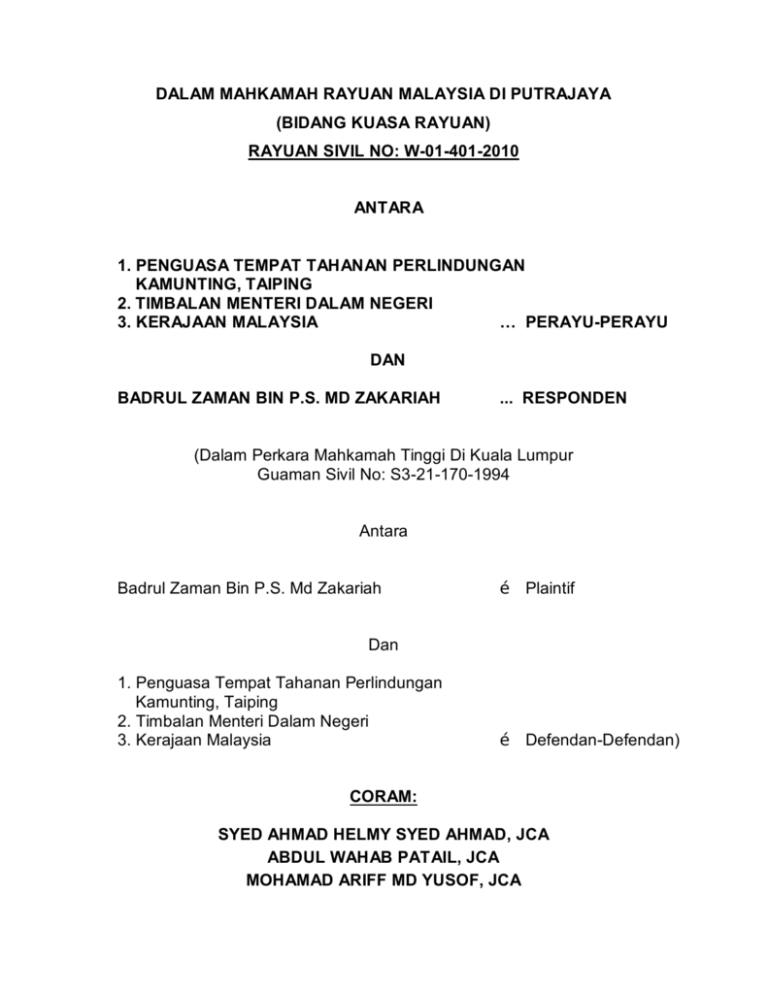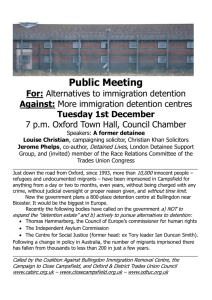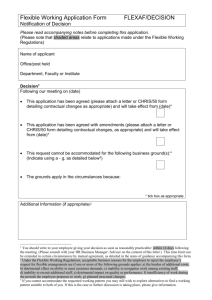DALAM MAHKAMAH RAYUAN MALAYSIA DI PUTRAJAYA
advertisement

DALAM MAHKAMAH RAYUAN MALAYSIA DI PUTRAJAYA (BIDANG KUASA RAYUAN) RAYUAN SIVIL NO: W-01-401-2010 ANTARA 1. PENGUASA TEMPAT TAHANAN PERLINDUNGAN KAMUNTING, TAIPING 2. TIMBALAN MENTERI DALAM NEGERI 3. KERAJAAN MALAYSIA … PERAYU-PERAYU DAN BADRUL ZAMAN BIN P.S. MD ZAKARIAH ... RESPONDEN (Dalam Perkara Mahkamah Tinggi Di Kuala Lumpur Guaman Sivil No: S3-21-170-1994 Antara Badrul Zaman Bin P.S. Md Zakariah … Plaintif Dan 1. Penguasa Tempat Tahanan Perlindungan Kamunting, Taiping 2. Timbalan Menteri Dalam Negeri 3. Kerajaan Malaysia … Defendan-Defendan) CORAM: SYED AHMAD HELMY SYED AHMAD, JCA ABDUL WAHAB PATAIL, JCA MOHAMAD ARIFF MD YUSOF, JCA GROUNDS OF JUDGMENT Introduction and Background Facts [1] The respondent, Badrul Zaman bin P.S. Md Zakariah, was detained under the Internal Security Act 1960 by order of the Deputy Minister of Home Affairs under section 8(1) of the Act. The initial order for preventive detention dated 12th September 1991 was for a period of two years. Towards the end of this initial period of detention, the respondent was served by the Deputy Minister with an extension order under section 8(7) of the Act for his further detention for another two years with effect from 14th September 1993. [2] This appeal was concerned with the validity of the extended detention order, not the validity of the initial detention order. As noted by the learned judge in the High Court, Mohd Hishamudin J (as his lordship then was), from whose decision this appeal was brought, “the validity of the initial ISA detention is not an issue in the case before me.” The learned Judge heard the writ action of the respondent as plaintiff in a common law claim for damages for wrongful detention or the tort of false imprisonment which was, on the facts, for a total of 300 days. [3] The initial detention order, made under section 8(1), stated the “purpose” of the detention, which was that the Minister was satisfied that it was necessary to make the detention order with a view to preventing the respondent from carrying out activities in whatever manner prejudicial to the security of Malaysia. This was in line with the stated statutory purposes under section 8 (1), reading: 2 “8. Power to order detention or restriction of persons. (1) if the Minister is satisfied that the detention of any person is necessary with a view to preventing him from acting in any manner prejudicial to security of Malaysia or any part thereof or to the maintenance of essential services and therein or to the economic life thereof, he may make an order (hereinafter referred to as a detention order) directing that person be detained for any period not exceeding two years.” [4] On the facts, it appeared that the respondent was also supplied with a “statement in writing” under section 11(2) (b) which included firstly, the “grounds” on which the order was made, and secondly, “the allegations of fact” on which the order was based. These requirements were complied with as mandated by section 11, so as to allow the detainee to make representations against the order to the Advisory Board. The full statutory provision reads: “Representations against detention order. 11. (1) A copy of every order made by the Minister under subsection 8(1) shall as soon as may be after the making thereof be served on the person to whom it relates, in every such person shall be entitled to make presentations against the order to an Advisory Board. (2) for the purpose of enabling a person to make representations under subsection (1) he shall, at the time of the service on him of the order - (a) be informed of his right to make representations to an Advisory Board under subsection (1); and (b) be furnished by the Minister with a statement in writing - (i) of the grounds on which the order is made; 3 (ii) of the allegations of fact on which the order is based; and (iii) of such other particulars, if any, as he may in the opinion of the Minister reasonably require in order to make representations against the order to the Advisory Board.…” [5] The detailed grounds and allegations of facts can be seen from pages 3 to 5 of Rekod Rayuan, Bahagian C, Jilid 1. These particulars were very extensive and included the exact acts carried out by the respondent. [6] The “grounds” (“Alasan-Alasan untuk Perintah Tahanan”), for instance, specified: “Bahawa kamu, BADRUL ZAMAN BIN S.P. MD. ZAKARIAH, sejak bulan April 1986 sehingga ditangkap pada 19 Julai 1991 dengan sedar dan rela hati telah melibatkan diri dalam kegiatan-kegiatan memalsukan dokumen-dokumen perjalanan Malaysia serta menguruskan penghantaran rakyat warganegara asing berhijrah ke negara ketiga daripada Malaysia dengan menggunakan dokumen-dokumen yang telah dipalsukan oleh kamu di mana dengan kegiatan kamu ini boleh memudaratkan keselamatan Malaysia.” [7] The allegations of fact (“Butir-Butir Pertuduhan”) then, inter alia, specified: “1. Di antara akhir bulan April 1986 hingga bulan April 1988, kamu dengan secara salah dari segi undang-undang telah Berjaya menghantar seramai 32 orang rakyat warganegara asing Sri Lanka yang kamu ketahui telah dicop visa palsu di dalam Paspot 4 Sri Lanka tersebut berhijrah ke negara ketiga melalui Lapangan Terbang Antarabangsa Subang (LTAB). 2. Di antara bulan Februari dan bulan Mac 1988 hingga 30 Jun 1991, kamu dengan secara menyalahi undang-undang telah Berjaya menghantar lebih kurang 175 orang rakyat warganegara India yang telah tinggal melebihi tempoh lawatan yang ditetapkan di Negara Malaysia atau “overstay” pulang ke negara asal mereka melalui Lapangan Terbang Antarabangsa Subang…” [8] When, after the expiry of the initial period of detention, the Deputy Minister acted under section 8(7) to direct the detention order to be extended, the respondent was not, however, supplied with grounds and allegations of fact. [9] All that appeared in the “Perlanjutan Perintah Tahanan” was the following: “BAHAWASANYA pada 12 haribulan September 1991 dengan tujuan hendak mencegah orang yang tersebut di bawah dari bertindak dengan cara yang memudaratkan: (a) Keselamatan Malaysia,… suatu Perintah Tahanan telah dibuat di bawah seksyen 8(1) Akta Keselamatan Dalam Negeri, 1960, yang mengarahkan bahawa orang yang tersebut di bawah hendaklah ditahan selama dua tahun mulai dari 16 haribulan September 1991… DAN BAHAWASANYA saya adalah berpuashati bahawa dengan tujuan hendak mencegah orang yang tersebut di atas dengan apa cara yang memudaratkan: 5 (b) Keselamatan Malaysia, … adalah perlu bahawa tempoh Perintah Tahanan itu dilanjutkan…MAKA, OLEH DEMIKIAN, pada menjalankan kuasa yang diberi kepada saya oleh seksyen 8(7) Akta Keselamatan Dalam Neneri 1960, saya, Menteri Hal Ehwal Dalam Negeri, Malaysia, dengan ini mengarahkan bahawa orang tersebut di atas itu hendaklah ditahan selama tempoh dua tahun selanjutnya mulai tarikh tamat tempoh Perintah Tahanan itu, iaitu dari 14 haribulan September 1993 di tempat Tahanan Perlindungan Kemunting, Taiping atau di mana-mana tempat lain yang diarahkan oleh saya dari semasa ke semasa. ….. (Dato’ Megat Junid bin Megat Ayob)……….. TIMBALAN MENTERI DALAM NEGERI, Malaysia” We emphasise the word “Tujuan” in the opening sentence of this order. [10] The precise statutory provisions under section 8(7) provide: “(7) The Minister may direct that the duration of any detention order or restriction order be extended for such further period, not exceeding two years, as he may specify, and thereafter for such further periods, not exceeding two years at a time, as he may specify, either - (a) on the same grounds as those on which the order was originally made; (b) on grounds different from those on which the order was originally made; or (c) partly on the same grounds and partly on different grounds. Provided that if a detention order is extended on different 6 grounds or partly on different grounds the person to whom it relates shall have the same rights under section 11 as if the order extended as aforesaid was a fresh order, and section 12 shall apply accordingly.” The Habeas Corpus Action in High Court, Penang [11] A habeas corpus application was then filed by the present respondent in the High Court, Penang. That was heard before Selventhiranathan JC (as his lordship then was), who in his unreported judgment in 1994 (see [1994] MLJU 1), allowed the application and ordered the respondent’s release. The Penang High Court ruled that the extended detention order was unlawful and unconstitutional. [12] Hishamudin J referred to this earlier decision extensively and concurred with the conclusion of the High Court, Penang, which his lordship described as a “well-reasoned judgment” with which he entirely agreed. [13] The High Court, Penang held the failure to provide grounds and allegations of fact for the extended detention resulted in the continued detention being in contravention of not only section 8(7), 11 and 12 of the Internal Security Act,1960, but also Articles 5(1) and 151(1) of the Federal Constitution. Thus, the Court held the respondent had been deprived of his personal liberty not in accordance with law. [14] Since the extension order was silent on grounds and allegations of fact, it “brings home clearly the denial to the applicant of his right to know on what grounds he was continuing to be detained so as to enable 7 him to decide whether or not to exercise his constitutional right to make representations to the advisory board” (per Selventhiranathan JC at page of the Judgment). [15] There was an appeal lodged against the decision of the Penang High Court, but that was subsequently withdrawn. This important fact was noted by Hishamudin J: “Initially, the defendants in the habeas corpus proceeding (who are also the defendants in the present case) had appealed against the decision of the Penang High Court, but subsequently they abandoned the appeal. Hence the judgment of the Penang High Court, which had ruled that the plaintiff’s extended preventive detention was unlawful and unconstitutional, stands until today.” The High Court Judgment [16] Based on this clear finding of the Penang High Court, Hishamudin J allowed both general and exemplary damages for the respondent for RM3,000,000.00 and RM300,000.00 respectively. Our Decision on the Appeal [17] We agreed with the finding of Hishamudin J and his Lordship’s reliance on the earlier decision of the Penang High Court that the extended preventive detention was unlawful and unconstitutional, and consequently dismissed the appeal on liability and affirmed the order of the High Court on the issue of liability. However, we could not agree that the quantum awarded could be justified in the circumstances. The appeal on quantum was therefore allowed in part, with the order of the 8 High Court set aside. In place of the quantum awarded by the High Court, we substituted the award with an award for the sum of RM300,000 as general damages with interest as claimed from the date of filing of the Writ of Summons until full settlement. We did not award exemplary damages. [18] We now state our reasons for dismissing the appeal on liability, and allowing the appeal on quantum in part. Issue on Liability [19] As for the issue of liability, it was obvious that in the absence of an appeal (it being withdrawn) the decision of the Penang High Court remained valid, and therefore the finding of liability for wrongful detention or false imprisonment for the 300 days was justified. Hishamudin J, in a very detailed judgment, carefully analysed the findings of the Penang High Court and the effect on it of the subsequent decision of the Federal Court in Gurcharan Singh Bachittar Singh v Penguasa, Tempat Tahanan Kamunting, Taiping & Ors [2002] 4 CLJ 249. [20] Hishamuddin J also analysed in depth the Judgments of the High Court, Court of Appeal and the Federal Court in Gurcharan Singh, supra, from pages 23 to 42 of his lordship’s judgment. [21] His lordship acknowledged that the legal issue in Gurcharan Singh and the present case on appeal was similar, although the facts in Gurcharan Singh were different. In Gurcharan Singh, the initial detention was likewise extended under section 8(7), but no grounds and allegations of fact were supplied. The purpose of the detention was 9 specified, namely with a view to preventing the detainee from acting in any manner prejudicial to the security of Malaysia. As for the initial detention, the detainee was supplied with the grounds of detention in addition to the “purpose”. [22] Before the High Court, the detainee (who had taken a writ action, not a habeas corpus application) succeeded in persuading the trial judge (James Foong J (as he then was) that the continued detention was null and void. Hishamudin J referred to this decision as a “sound decision”, since James Foong J took the same position as Selventhiranathan J in the Penang High Court. On appeal to the Court of Appeal, however, the High Court decision was reversed by a majority decision. The majority took the view that the “purpose” as stated in the initial detention order under section 8(1) and the extended order under section 8(7) was in fact and in law the “grounds” for the detention. [23] The dissenting judgment (by Abdul Malek Ahmad JCA), however, applied the view of Selventhiranathan J in the Penang High Court. Indeed, Abdul Malek Ahmad JCA followed the views expressed by Suffian FJ in Karam Singh v Menteri Hal Ehwal Dalam Negeri [1969] 2 MLJ 129, itself another Federal Court decision. The relevant excerpt from Karam Singh, supra, was cited by Hishamudin J at page 37 of the High Court’s Judgment: “It seems to me that there has been confusion in this matter by Dato’ Marshall’s frequent use throughout his arguments of the word “grounds”. In my judgment, the words “with a view to preventing that person from acting in any manner prejudicial to the security of Malaysia or any part thereof or to the maintenance of public order or essential services therein” in section 8(1)(a) of the 10 Internal Security Act do not indicate the grounds for a person’s detention; they indicate its purpose or purposes. It is true that the grounds for a person’s detention must be given, but grounds are quite distinct from purposes…” [24] We noted that Hishamudin J had some difficulty in reconciling the Federal Court decision in Gurcharan Singh, supra, with the Penang High Court decision. His lordship was of the view that “the judgment of the Federal Court in Gurcharan Singh is unclear and appears (with the greatest respect and humility) to be self-contradictory.” (See page 22 of the Judgment.) The Federal Court in part referred to and applied the dissenting judgment of the Court of Appeal, but nevertheless held the “purposes” in Article 8(1) to be “grounds”. The Federal Court dismissed the appeal brought by the detainee, and to that extent, being a subsequent decision, the correctness of the decision of the Penang High Court in this present appeal, could be open to question. All said, the fact remained that this Penang High Court decision stood undisturbed and unchallenged since the respondents withdrew the appeal. Despite Gurcharan Singh, this appeal had to proceed on the basis of the Penang High Court decision being valid and binding. We agreed with his lordship’s main argument that Gurcharan Singh was in fact irrelevant for the purpose of the claim for damages for false imprisonment or wrongful detention. The appellants could not be blowing hot and cold at the same time; they could have pursued the appeal from the Penang High Court, but did not. They had to be held to their election as a matter of law. Thus, strictly speaking there was no necessity to decide whether the reasoning in Gurcharan Sigh should apply, since the appellants had voluntarily elected to regard the Penang High Court decision as valid and correct by not appealing. 11 [25] We might note in passing that there appears to be some uncertainty and possible contradiction between the Federal Court views in Karam Singh and Gurcharan Singh on the proper interpretation of section 8(1). [26] As a matter of strict interpretation, there is much to be commended in the position adopted by the Penang High Court and preferred by Hishamudin J whereby the statutory scheme demarcates carefully “purposes”, “grounds” and “allegations of fact” as distinct statutory components. On the facts of this appeal, the documents supplied by the Deputy Minister under section 8(1) and (7) (quoted earlier in this Judgment) complied with this three-fold categorisation. It would have seemed odd to insist that “Tujuan” has to be read as meaning the same as “Alasan-Alasan untuk Perintah Tahanan”, on the facts of this present appeal. Section 8B(1) [27] In the course of submission before us, a new point was raised by the appellants. This referred to the effect of the exclusionary clause, Section 8B(1) of the Internal Security Act, reading: “There shall be no judicial review in any court of, and no court shall have or exercise any jurisdiction in respect of, any act done or decision made by the Yang di Pertuan Agong or the Minister in the exercise of their discretionary power in accordance with this Act, save in regard to any question on the compliance with any procedural requirement in this Act governing such act or decision.” 12 [28] This was a point not pleaded in the Memorandum of Appeal. Nor was it argued in the High Court below. Before us, the appellants then attempted to argue that the courts have no jurisdiction to entertain any claim for damages for unlawful imprisonment or wrongful detention, since “judicial review” is very broadly defined in Section 8C of the same Act, to include proceedings instituted by way of; (a) Mandamus, prohibition and certiorari; (b) Declarations; (c) Habeas corpus; and (d) Any other suit, action or other legal proceedings relating to or arising out of any act done or decision made by the Minister. [29] While it is true that the Court of Appeal can consider a point not expressly taken in the Memorandum of Appeal or argued in the court below based on the broad wording of Section 69(4) of the Courts of Judicature Act 1964 and r,18(2) of the Rules of the Court of Appeal 1994, this is subject to the overriding discretion of this Court to do justice. Where the justice of the case requires a departure from the rule that parties should be bound by the grounds in the Memorandum of Appeal, the court may allow a new point to be argued. See Luggage Distributors (M) Sdn Bhd v Tan Hor Teng & Anor [1995] 1 MLJ 719 (“The factors for and against the admission of the new point must be weighed on a balance to see where the justice of the case lie.”); See also Cheow Chew Khoon v Abdul Johari bin Abdul Rahman [1995] 1 MLJ 457; Mohd Azam Shuja & Ors v United Malayan Banking Bhd [1995] 2 MLJ 851 (“The question whether effect should be given to a 13 point raised for the first time…is one of discretion and the court can consider it in the interests of justice.”) [30] The argument taken was quite fundamental and should have, at the very least, been included as a ground of appeal. The respondent was right in objecting to the attempt by the appellant to submit on this basis. In any event, we very much doubted whether the reading of Section 8B(1), read in conjunction with Section 8C, is correct. A straightforward application of the euisdem generis rule would show Section 8B(1) addresses only direct challenges to the validity of a detention order by “judicial review”. It has little to do with a suit for damages arising from a “judicial review” proceeding. [31] Consequently, we found no merit in the submission taken on the effect of section 8B(1) and the attempt to preclude this Court from exercising jurisdiction in this appeal. Issue on Quantum [32] As indicated earlier in this Judgment, the appeal on quantum was allowed in part. In place of the quantum awarded by the High Court, we substituted the award with an award for the sum of RM300,000.00 as general damages with interest as claimed from the date of filing of the Writ of Summons until full settlement, and did not award exemplary damages. In our assessment, the general damages of RM3,000,000.00 and exemplary damages of RM300,000.00 respectively awarded to the respondent were, in the circumstances, too high, since pegged at the rate of RM20,000.00 per day, and despite the discount of 50% given on a straight-line basis. His lordship did not provide a clear justification why 14 RM20,000.00 per day was fair and reasonable to compensate the respondent on the accepted principles for the award of damages in wrongful detention or false imprisonment cases. In Abdul Malek Hussin v Borhan Hj Daud & Ors [2008] 1 CLJ 264, his lordship awarded RM25,000.00 per day for false imprisonment, but his lordship observed that this decision had been reversed by the Court of Appeal and therefore did not follow this decision as a guide. Observing that there was a dearth of local authorities on the award of damages for false imprisonment, two English authorities were referred to, namely Thompson v Commissioner of Police of the Metropolis [1998] QB 498 and Reg. v Governor of Brixton Prison, ex parte Evans (No. 2) [1999] QB 1043. These decisions were also said to offer merely “rough guides”. [33] We were referred to the governing principles applicable as laid down in McGregor on Damages and the learned commentator’s observations as follows: “The details on how damages are worked out in false imprisonment are few: generally it is not pecuniary loss but a loss of dignity and the like and is left much to the jury’s and judge’s discretion. The principal heads of claim would appear to be the injury to liberty, i.e. the loss of time considered primarily from a non-pecuniary viewpoint, and the injury to feelings, i.e. the indignity, mental suffering, disgrace and humiliation with any attendant loss of social status and injury to reputation…In addition there may be recovery for any resultant physical injury, illness or discomfort…further any pecuniary loss which is not too remote is recoverable; there appears to be no modern reported cases…that any loss of general business or employment is recoverable would seem to follow from Childs v Lewis…” 15 [34] From the authorities, it appears accepted that damages for false imprisonment has first and foremost to be grounded on loss of dignity, not pecuniary loss. The principal head of claim is loss of liberty. It will be incorrect to treat the award of damages here as a pecuniary loss per se. However, damages awarded must be “sufficient” since it will be in the public interest to award more than nominal damages “in order to give reality to the protection afforded by law to personal freedom” (Tan Kay Teck v Attorney General [1957] 1 MLJ 237). Counsel for the respondent impressed upon us that in Tan Kay Teck, supra, the Court awarded $1,000.00 for a deprivation of liberty of six hours in 1957. In another case, Shaaban & Anor v Chong Fook Kam & Anor [1965] 2 MLJ 50 (Federal Court), RM2,500.00 was awarded for loss of liberty of a mere nine hours. See also the opinion of the Judicial Committee of the Privy Council on appeal [1969] 2 MLJ 219 where the JCPC held the RM2,500.00 was “extremely high”. At page 222 (left-hand column), the JCPC said: “The sum of $2,500.00 for each plaintiff seems to their Lordships on any view to be extremely high. Judging by the special damage pleaded in the Statement of Claim, it is equivalent to five months’ wages with overtime. On the view that the Board has taken of the facts on this case, this is undoubtedly excessive. On this view the scope for compensatory damages is limited; they must be confined to approximately nine hours’ detention in the company of the police. The court is not in this category of case confined to awarding compensation for loss of liberty and for such physical and mental distress as it thinks may have been caused. It is also proper for it to mark any departure from constitutional practice, even if only a slight one, by exemplary damages; but these do not have to be large…..” 16 [35] In our view, the authorities do not support a simple linear calculation, for it will lead to the award of excessive damages where the detention is over an extended period. After the first period of detention, damages will require to be calculated “on a progressively reducing scale”. See the relevant commentary by McGregor (at paragraph 37008; page 1397): “…in Thompson v Commissioner of Police of the Metropolis and Hsu v Commissioner of Police of the Metropolis, guidance has been given by the Court of Appeal as to the amount to be awarded for the basic damages, these being described as the before the element of aggravation and also being damages before any pecuniary loss, any physical injury or any injury to reputation should these occur. For the first hour of imprisonment [Pounds] 500 was held to be appropriate. The sums to be awarded after the first hour should be on a progressively reducing scale…” [36] Thus, based on these principles as observed by the learned authors of McGregor on Damages, we could not agree with the learned Judge’s method of calculation and the award of 50% discount on a straight line basis. [37] The respondent succeeded only in respect of the extended period of detention for non-compliance of statutory and constitutional provisions, and what was undeniably a deprivation of his constitutional rights. To this extent, his victory was a technical one. The award of damages should reflect this. For this reason, we were not satisfied that there was sufficient justification to award exemplary damages. In these circumstances, we felt a sum of RM300,000.00 was a fair and reasonable sum for the unlawful imprisonment and wrongful detention. 17 After all, it worked out to be damages of RM1,000.00 per day over 300 days of detention. This sum would be sufficient to compensate him for the loss of dignity and liberty, as well as “to give reality to the protection afforded by law to personal freedom.” Conclusion [38] For the reasons stated above, we consequently dismissed the appeal on liability and affirmed the order of the High Court on the issue of liability. The appeal on quantum was allowed in part, with the initial order of the High Court on quantum set aside and substituted with an award for the sum of RM300,000.00 as general damages with interest as claimed from the date of filing of the Writ of Summons until full settlement. We did not order exemplary damages. We fixed costs at RM15,000.00 to be paid to the respondent. Sgd (DATO’ MOHAMAD ARIFF BIN MD. YUSOF) Judge Court of Appeal Malaysia Dated: 18th March 2014 18 Counsels/Solicitors For the appellants: Suzana binti Atan Peguam Kanan Persekutuan Jabatan Peguam Negara Malaysia Bahagian Guaman Aras 3, Blok C3, Kompleks C 62512 Putrajaya For the respondent: M. Manoharan Messrs M. Manoharan & Co Suite B-4-1, Tower B Wisma Pantai, Plaza Pantai Off Jalan Pantai Baru 59200 Kuala Lumpur 19





